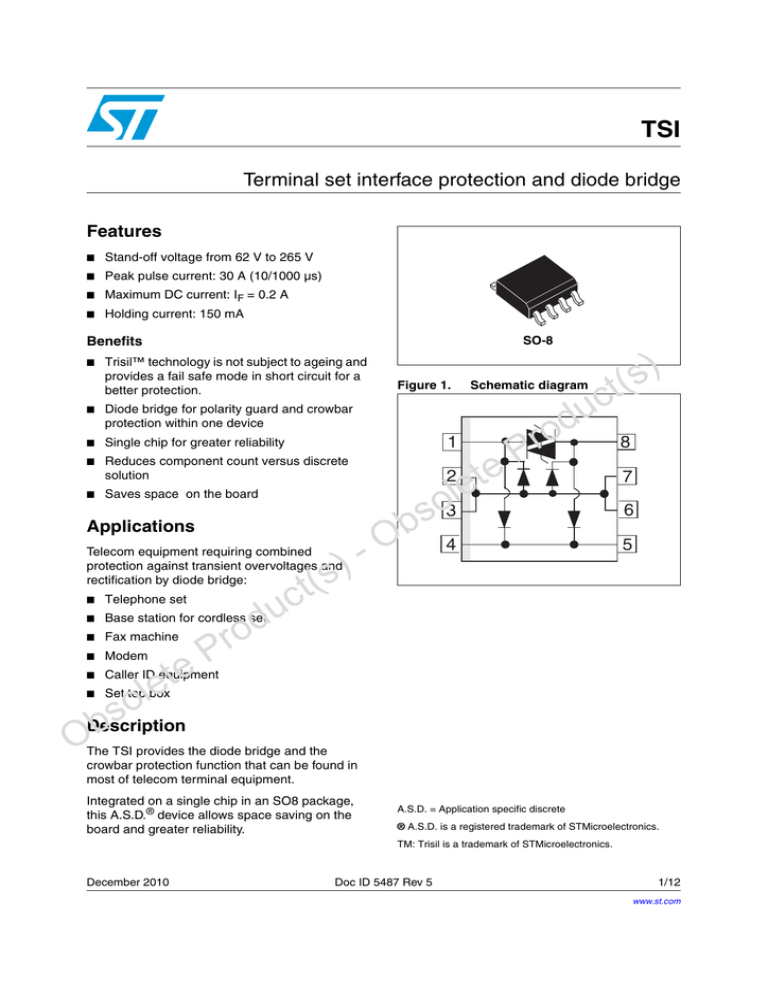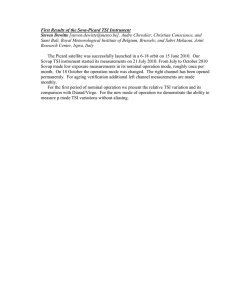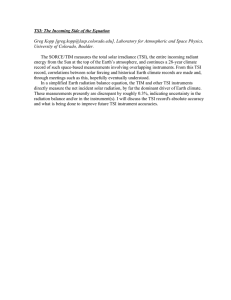
TSI
Terminal set interface protection and diode bridge
Features
■
Stand-off voltage from 62 V to 265 V
■
Peak pulse current: 30 A (10/1000 µs)
■
Maximum DC current: IF = 0.2 A
■
Holding current: 150 mA
SO-8
Benefits
■
Trisil™ technology is not subject to ageing and
provides a fail safe mode in short circuit for a
better protection.
Figure 1.
Schematic diagram
■
Diode bridge for polarity guard and crowbar
protection within one device
■
Single chip for greater reliability
1
■
Reduces component count versus discrete
solution
2
■
Saves space on the board
Applications
Telecom equipment requiring combined
protection against transient overvoltages and
rectification by diode bridge:
■
Telephone set
■
Base station for cordless set
■
Fax machine
■
Modem
■
Caller ID equipment
■
Set top box
)
s
(
ct
e
t
le
c
u
d
o
r
P
o3
s
b 4
O
-
)
s
t(
8
7
6
5
u
d
o
r
P
e
t
e
l
o
s
b
O
Description
The TSI provides the diode bridge and the
crowbar protection function that can be found in
most of telecom terminal equipment.
Integrated on a single chip in an SO8 package,
this A.S.D.® device allows space saving on the
board and greater reliability.
A.S.D. = Application specific discrete
® A.S.D. is a registered trademark of STMicroelectronics.
TM: Trisil is a trademark of STMicroelectronics.
December 2010
Doc ID 5487 Rev 5
1/12
www.st.com
12
Characteristics
1
TSI
Characteristics
Table 1.
Compliant with the following standards
Peak surge
Voltage
Required peak
Current
voltage (V) waveform (µs)(1)
current (A)
waveform (µs)(1)
Standard
ITT K17 - K20
1500
VDE 0433
10/700
2000
38
5/310
(2)
10/700
5/310
40A
1. See Figure 2.
2. With series resistors or PTC
Table 2.
Absolute maximum ratings (Tamb = 25 °C)
Symbol
Parameter
Peak pulse current(1)
10/1000 µs
5/310 µs
2/10 µs
IPP
Non repetitive surge peak on-state current
(F = 50 Hz)
Tstg
Tj
Storage temperature range
Maximum junction temperature range
Table 3.
Thermal resistance
Symbol
Rth(j-a)
Figure 2.
e
t
le
o
r
P
o
s
b
O
Parameter
(s)
Junction to ambient
t
c
u
Pulse waveform
d
o
r
P
e
2/12
c
u
d
t = 10ms
t = 1s
Maximum lead temperature for soldering during 10 s
1. See Figure 2.
s
b
O
30
40
75
ITSM
TL
t
e
l
o
Value
% I
PP
Repetitive peak pulse current
10 0
tr = rise time (µs)
tp = pulse duration time (µs)
50
0
tr
tp
Doc ID 5487 Rev 5
t
5
3.5
Unit
)
s
t(
A
A
- 55 to + 150
°C
260
°C
Value
Unit
170
°C/W
TSI
Characteristics
Table 4.
Electrical characteristics - definitions (Tamb = 25 °C)
Symbol
Parameter
VRM
Stand-off voltage
VBO
Breakover voltage
VBR
Breakdown voltage
IBO
IH
IH
Holding current
IBO
Breakover current
IRM
Leakage current at VRM
IPP
Peak pulse current
IRM
Capacitance
αT
Temperature coefficient
Electrical characteristics - values (Tamb = 25 °C)
IRM @ VRM
Order code
VBO(1)
IH
max.
min.
min.
mA
max.
TSI220B1
µA
V
V
mA
1
5
50
220
330
150
2. VR = 0 V, F = 1 MHz, between pins 1 and 8
Thermal resistances
Symbol
VF (for one diode)
o
s
b
O
Parameter
(s)
IF = 20 mA
IF = 100 mA
t
c
u
50
VBO
)
s
t(
C(2)
IBO(1)
r
P
e
t
le
1. Measured at 50 Hz, one cycle
Table 6.
V
VRM
C
Table 5.
I
IPP
uc
max.
od
typ.
mA
pF
400
200
Value
Unit
0.9
1.1
V
d
o
r
P
e
t
e
l
o
s
b
O
Doc ID 5487 Rev 5
3/12
Typical application
2
TSI
Typical application
Figure 3.
Application schematic
PTC
TSI
Ligne A
Hook
Speech
dialing
ringer
Ligne B
c
u
d
)
s
t(
Telecom terminals have a diode bridge for polarity guard located at the line interface stage.
They also have above this diode bridge one crowbar protection device that is mandatory to
prevent atmospheric effects and AC mains disturbances from damaging the electronic
circuitry that follows the diode bridge.
o
r
P
STMicroelectonics proposes a single-chip device that includes both protection and the diode
bridge. This is the concept of the TSI devices.
Figure 4.
e
t
le
o
s
b
O
-
Uses of the TSI in a conventional telecom network
)
s
(
ct
Central office
Telephone set
Answering
machine
u
d
o
r
P
e
PABX
Exchange
Answering
machine
t
e
l
o
s
b
O
Modem
Computer
WLL
4/12
Telephone set
Doc ID 5487 Rev 5
TSI
Electrical parameters
3
Electrical parameters
The VRM value corresponds to the maximum voltage of the application in normal operation.
For instance, if the maximum line voltage is ranging between 100 VRMS of ringing plus 48 V
of battery voltage, then the protection chosen for this application shall have a VRM close to
200 V.
VBO is the triggering voltage. This indicates the voltage limit for which the component shortcircuits. Passing this VBO makes the device turn on.
IBO is the current that makes the device turn on. Indeed, if we want a Trisil to be turned on
not only the voltage across it shall pass the VBO value but the current through it shall also
pass the IBO value.
In other words, if a voltage surge occurring on the line is higher than the VBO value of a
Trisil, but the line surge current is limited to a value that does not exceed the Trisil’s IBO
value, then the Trisil will never turn into a short-circuit. At this time the surge will be clamped
by the Trisil.
)
s
t(
The electronic circuitry located after the Trisil will always be protected whatever the Trisil
state is (crowbar or clamping mode).
c
u
d
IH is the holding current. When the Trisil is turned on, as soon as the crossing current surge
gets lower than this IH value, the Trisil protection device turns back in its idle state. For this
reason the Trisil’s IH value shall be chosen to be higher than the maximum telecom line
current can be.
o
r
P
3.1
e
t
TSI behavior with regard to surge standard
le
o
s
b
O
)
s
(
t
c
u
d
o
r
P
ete
The TSI replaces both diode bridge and usual discrete protection on telecom terminals.
Furthermore, it complies with the ITT K17 recommendations:
●
10/700 µs waveform surge test ±1.5 kV
●
AC power induction test
●
AC power contact test
Figure 5.
Test circuit for the ITT K17 recommendations
PTC
b
O
l
o
s
10 Ω
Surge
generator
LA
TSI
Telecom
line side
LB
Doc ID 5487 Rev 5
5/12
Electrical parameters
3.1.1
TSI
10/700 µs waveform surge - lightning simulation
This test concerns the 10/700 µs waveform surge ±1.5 kV.The surge generator used for the
test has the following circuitry (Figure 6).
Figure 6.
10/700 µs waveform surge generator circuit
W
W
W
)
s
t(
The behaviour of the TSI to this lightning surge is given below (Figure 7 and Figure 8).
Figure 7.
c
u
d
Voltage across + and - terminals of Figure 8.
TSI and current for 1.5 kV positive
surge
Voltage (50 V /div)
Voltage across + and - terminals of
TSI and current for 1.5 kV negative
surge
Voltage (50 V /div)
e
t
le
(t s)
o
r
P
o
s
b
O
-
2 µs/div
uc
Current (5 A/div)
2 µs/div
Current (5 A/div)
d
o
r
P
e
t
e
l
o
s
b
O
2 µs/div
2 µs/div
These curves show the peak voltage the surge generates across the TSI + and - terminals.
This lasts a short time ( 2 μs) and after, as the internal protection behaves like a short circuit,
the voltage drop across the TS1 becomes a few volts. In the meantime all the surge current
flows through the protection device.
As far as the 10/700 µs waveform surge test is concerned,the TSI withstands the ±1.5 kV
test.
6/12
Doc ID 5487 Rev 5
TSI
3.1.2
Electrical parameters
AC power induction test
This test simulates the induction phenomena that can happen between telecom lines and
AC mains lines (Figure 9).
Figure 9.
AC power induction test circuit
I
PTC
R
LA
10 W
TSI
T
Telecom
ligne side
Vrms
50 Hz
V
LB
Part 1
c
u
d
Test conditions:
●
VRMS = 240 V
●
R = 600 Ω
●
t = 0.2 s
e
t
le
Part 2
Test condition :
●
VRMS = 600 V
●
R = 600 Ω
●
t = 0.2 s
)
s
(
ct
)
s
t(
o
r
P
o
s
b
O
-
Figure 10. Voltage across + and - terminals of TSI and current during test part 1
u
d
o
Voltage (50 V/div)
r
P
e
s
b
O
t
e
l
o
5 ms/div
Current (0.2 A/div)
5 ms/div
The TSI withstands the AC power induction test in both cases.
Doc ID 5487 Rev 5
7/12
Electrical parameters
3.1.3
TSI
AC power contact test
This test simulates the direct contact between the telecom lines and the AC mains lines.
The AC power contact test consists in applying 240 VRMS through a 10 Ω PTC for 15
minutes to the device under test. The ITT K17 recommendation specifies an internal
generator impedance allowing 10 ARMS when in short circuit.
The behavior of the TSI with respect to this surge is given in Figure 11.
Figure 11. Voltage across + and - terminals of TSI and current during the test
Voltage (50 V/div)
50 ms/div
c
u
d
Current (5 A/div)
e
t
le
so
b
O
-
)
s
t(
o
r
P
50 ms/div
Figure 11 shows that after 250 ms there is no current flowing through the TSI device. This is
due to the action of the serial PTC that limits the current through the line. This PTC is
mandatory for this test. It can also be replaced by a fuse or any other serial protection that
“opens” the line loop under AC contact test.
)
s
(
ct
u
d
o
r
P
e
t
e
l
o
s
b
O
8/12
Doc ID 5487 Rev 5
TSI
4
Ordering information scheme
Ordering information scheme
Figure 12. Ordering information scheme
TPN 220 B 1 RL
Terminal set interface
Breakdown voltage
220 = 220 V
Package
1 = SO-8 plastic
Packing
RL = Tape and reel
Blank = Tube
c
u
d
e
t
le
)
s
(
ct
)
s
t(
o
r
P
o
s
b
O
-
u
d
o
r
P
e
t
e
l
o
s
b
O
Doc ID 5487 Rev 5
9/12
Package information
5
TSI
Package information
●
Epoxy meets UL94, V0
●
Lead-free package
In order to meet environmental requirements, ST offers these devices in different grades of
ECOPACK® packages, depending on their level of environmental compliance. ECOPACK®
specifications, grade definitions and product status are available at: www.st.com.
ECOPACK® is an ST trademark.
Table 7.
SO-8 dimensions
Dimensions
Ref.
Min.
Seating
Plane
C
A2
A
L
k
ppp C
L1
D
A1
0.1
A2
1.25
b
0.28
C
0.17
D
4.80
so
E
e
4
1
(s)
h
b
O
-
ct
u
d
o
t
e
l
o
s
b
O
10/12
Typ.
Max.
L
o
r
P
0.23
4.90
5.00
0.011
)
s
t(
0.010
c
u
d
0.049
0.007
0.019
0.009
0.189 0.193 0.197
5.80
6.00
6.20
0.228 0.236 0.244
3.90
4.00
0.150 0.154 0.157
1.27
0.25
0.40
0.050
0.50
0.010
1.27
0.016
1.04
0°
ppp
0.6
(0.024)
4.2
(0.165)
1.27
(0.050)
0.020
0.050
0.041
8°
0.10
6.8
(0.268)
Doc ID 5487 Rev 5
0.004
3.80
L1
k
0.069
0.48
Figure 13. Footprint, dimensions in mm (inches)
r
P
e
Min.
0.25
e
t
le
E1
E1
Max.
1.75
E
5
8
Typ.
Inches
h x 45°
C
A1
e
b
A
Millimeters
0°
8°
0.004
TSI
6
Ordering information
Ordering information
Table 8.
7
Ordering information
Ordering code
Marking
Package
Weight
TSI220B1
TSI220
SO-8
0.08g
Revision history
Table 9.
Document revision history
Date
Revision
Changes
Oct-2003
4
Last release
14-Dec-2010
5
Updated trademark statements. Removed order codes that are no longer
available.
c
u
d
e
t
le
)
s
(
ct
)
s
t(
o
r
P
o
s
b
O
-
u
d
o
r
P
e
t
e
l
o
s
b
O
Doc ID 5487 Rev 5
11/12
TSI
Please Read Carefully:
Information in this document is provided solely in connection with ST products. STMicroelectronics NV and its subsidiaries (“ST”) reserve the
right to make changes, corrections, modifications or improvements, to this document, and the products and services described herein at any
time, without notice.
All ST products are sold pursuant to ST’s terms and conditions of sale.
)
s
t(
Purchasers are solely responsible for the choice, selection and use of the ST products and services described herein, and ST assumes no
liability whatsoever relating to the choice, selection or use of the ST products and services described herein.
c
u
d
No license, express or implied, by estoppel or otherwise, to any intellectual property rights is granted under this document. If any part of this
document refers to any third party products or services it shall not be deemed a license grant by ST for the use of such third party products
or services, or any intellectual property contained therein or considered as a warranty covering the use in any manner whatsoever of such
third party products or services or any intellectual property contained therein.
e
t
le
o
r
P
UNLESS OTHERWISE SET FORTH IN ST’S TERMS AND CONDITIONS OF SALE ST DISCLAIMS ANY EXPRESS OR IMPLIED
WARRANTY WITH RESPECT TO THE USE AND/OR SALE OF ST PRODUCTS INCLUDING WITHOUT LIMITATION IMPLIED
WARRANTIES OF MERCHANTABILITY, FITNESS FOR A PARTICULAR PURPOSE (AND THEIR EQUIVALENTS UNDER THE LAWS
OF ANY JURISDICTION), OR INFRINGEMENT OF ANY PATENT, COPYRIGHT OR OTHER INTELLECTUAL PROPERTY RIGHT.
o
s
b
O
-
UNLESS EXPRESSLY APPROVED IN WRITING BY AN AUTHORIZED ST REPRESENTATIVE, ST PRODUCTS ARE NOT
RECOMMENDED, AUTHORIZED OR WARRANTED FOR USE IN MILITARY, AIR CRAFT, SPACE, LIFE SAVING, OR LIFE SUSTAINING
APPLICATIONS, NOR IN PRODUCTS OR SYSTEMS WHERE FAILURE OR MALFUNCTION MAY RESULT IN PERSONAL INJURY,
DEATH, OR SEVERE PROPERTY OR ENVIRONMENTAL DAMAGE. ST PRODUCTS WHICH ARE NOT SPECIFIED AS "AUTOMOTIVE
GRADE" MAY ONLY BE USED IN AUTOMOTIVE APPLICATIONS AT USER’S OWN RISK.
)
s
(
ct
u
d
o
Resale of ST products with provisions different from the statements and/or technical features set forth in this document shall immediately void
any warranty granted by ST for the ST product or service described herein and shall not create or extend in any manner whatsoever, any
liability of ST.
r
P
e
t
e
l
o
ST and the ST logo are trademarks or registered trademarks of ST in various countries.
Information in this document supersedes and replaces all information previously supplied.
bs
The ST logo is a registered trademark of STMicroelectronics. All other names are the property of their respective owners.
O
© 2010 STMicroelectronics - All rights reserved
STMicroelectronics group of companies
Australia - Belgium - Brazil - Canada - China - Czech Republic - Finland - France - Germany - Hong Kong - India - Israel - Italy - Japan Malaysia - Malta - Morocco - Philippines - Singapore - Spain - Sweden - Switzerland - United Kingdom - United States of America
www.st.com
12/12
Doc ID 5487 Rev 5


